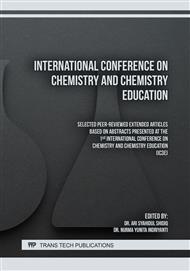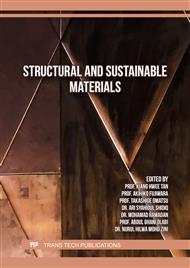[1]
C.R. Holkar, A.J. Jadhav, D.V. Pinjari, N.M. Mahamuni, and A.B. Pandit, A critical review on textile wastewater treatments: Possible approaches, Journal of Environmental Management, 182 (2016) 351–366.
DOI: 10.1016/j.jenvman.2016.07.090
Google Scholar
[2]
S. Benkhaya, S.El. Harfi, and A.El. Harfi, Classifications , properties and applications of textile dyes: A review. Applied Journal of Environmental Engineering Science, 3 (2018) 311-320.
DOI: 10.1016/j.inoche.2020.107891
Google Scholar
[3]
N. Sharma, D.P. Tiwari, and S.K. Singh, Introduction. Libraries in the Early 21st Century, volume 2, De Gruyter Saur, (2012).
Google Scholar
[4]
L. Indrayani, and N. Rahmah, Nilai Parameter Kadar Pencemar Sebagai Penentu Tingkat Efektivitas Tahapan Pengolahan Limbah Cair Industri Batik, Jurnal Rekayasa Proses, 12(1) (2018) 41-50.
DOI: 10.22146/jrekpros.35754
Google Scholar
[5]
Benkhaya et.al., A review on classifications, recent synthesis and applications of textile dyes, Inorganic Chemistry Communications, 107891 (2020) 1-36.
DOI: 10.1016/j.inoche.2020.107891
Google Scholar
[6]
N. Fatimah, Alimuddin, and R. Gunawan, Penentuan Intesitas Warna Rhemazol RED RB 133 dalam Limbah Batik dengan Elektrokoagulasi Menggunakan NaCl, Jurnal Atomik, 3(1) (2018) 39–46.
Google Scholar
[7]
S.S. Mohanty, and A. Kumar, Biodegradation of Indanthrene Blue RS dye in immobilized continuous upflow packed bed bioreactor using corncob biochar, Scientific Reports, 11(1) (2021) 1–13.
DOI: 10.1038/s41598-021-92889-3
Google Scholar
[8]
Riyanto, Inovasi Alat Pengolah Limbah Batik "Elektrobatik", Juranl Hasil Penelitian di Kabupaten Sleman, 2(1) (2015) 65-77.
Google Scholar
[9]
T. Murniati, Inayati, and S. Budiastuti, Pengolahan Limbah Cair Industri Batik dengan Metode Elektrolisis sebagai Upaya Penurunan Tingkat Konsentrasi Logam Berat di Sungai Jenes Laweyan Surakarta, Jurnal EKOSAINS, 3(1) (2015) 77-83.
DOI: 10.20961/ekuilibrium.v12i1.2176
Google Scholar
[10]
Q. Zheng, Y. Dai, and X. Han, Decolorization of azo dye C.I. Reactive Black 5 by ozonation in aqueous solution: influencing factors, degradation products, reaction pathway and toxicity assessment, Water Science & Technology, 73(7) (2016) 1500-1510.
DOI: 10.2166/wst.2015.550
Google Scholar
[11]
N.I. Wantoputri, Q. Helmy, and S. Notodarmojo, Textile Wastewater Post Treatment Using Ozonation, Jurnal Presipitasi, 18(1) (2021) 56-63.
DOI: 10.14710/presipitasi.v18i1.56-63
Google Scholar
[12]
E. Al-Abbad, and F. Alakhras, Removal of Dye Acid Red 1 from Aqueous Solutions Using Chitosan-iso-Vanillin Sorbent Material, Indonesian Journal of Science & Technology, 5(3) (2020) 352-365.
DOI: 10.17509/ijost.v5i3.24986
Google Scholar
[13]
S.B. Utomo, Aplikasi Lignoselulosa Sulfonat Ampas Tebu untuk Adsorpsi Zat Warna Tekstil Kationik Basic Violet 10, Jurnal Kimia Dan Pendidikan Kimia (JKPK), 1(1) (2016), 11-19.
DOI: 10.20961/jkpk.v1i1.10096
Google Scholar
[14]
U. Lusiana, Application of Calibration Curve, Accuracy and Precision Chart as Internal Quality Control at COD Testing in Wastewater, Biopropal Industri, 3(1) (2012) 1–8.
Google Scholar
[15]
D.R. Suminar, and N. Saksono, Pengaruh Kedalaman Anoda pada Metode Contact Glow Discharge Electrolysis (CGDE) dalam Degradasi Pewarna Tekstil Remazol Red, Jurnal Teknik Kimia Dan Lingkungan, 2(2) (2018), 66-74.
DOI: 10.33795/jtkl.v2i2.74
Google Scholar
[16]
I.N. Sukarta, Sintesis Membran Nata de Pina dan Aplikasinya untuk Adsorpsi Zat Warna Tekstil Remazol Red RB, Jurnal Kimia (Journal of Chemistry), 14(2) (2020) 126-141.
DOI: 10.24843/jchem.2020.v14.i02.p05
Google Scholar
[17]
M. Tamyiz, N.H. Hidayah, A. Salsabella, and T. Maulidiyah, Pemanfaatan Komposit Biosorben Tanah Liat dan Arang Bambu dalam Mengurangi Kandungan Zat Warna pada Limbah Cair Industri Batik, Jurnal Presipitasi, 16(3) (2019), 152-159.
DOI: 10.14710/presipitasi.v16i3.152-159
Google Scholar
[18]
N.P. Setianingrum, et.al., Pengurangan Zat Warna Remazol Red RB Menggunakan Metode Elektrokoagulasi Secara Batch, Jurnal Rekayasa Proses, 11(2) (2018), 78-85.
DOI: 10.22146/jrekpros.26900
Google Scholar



